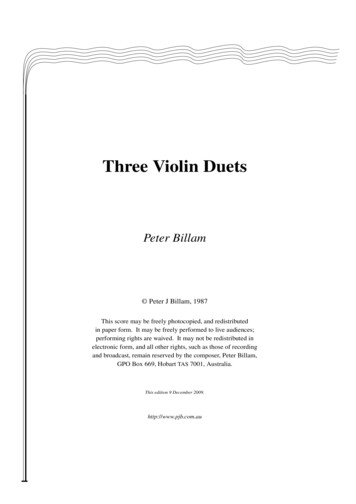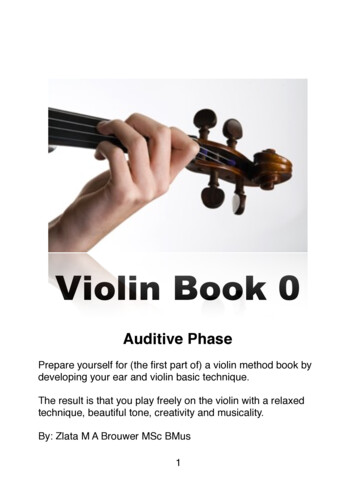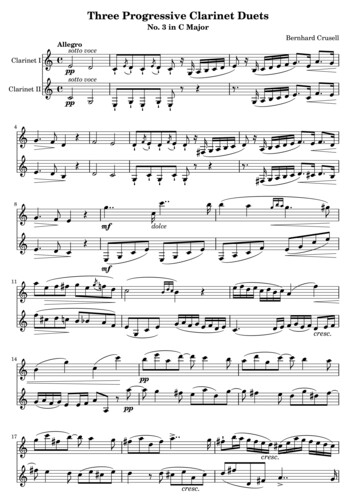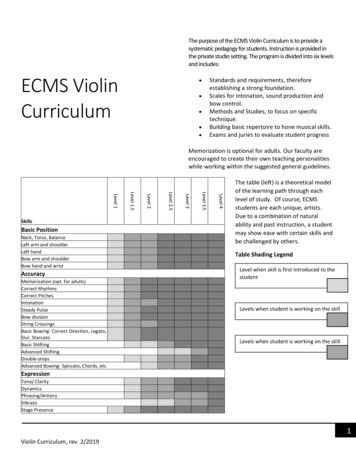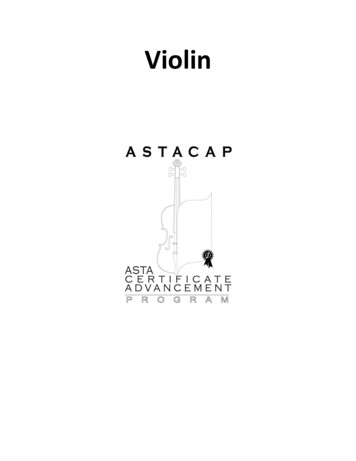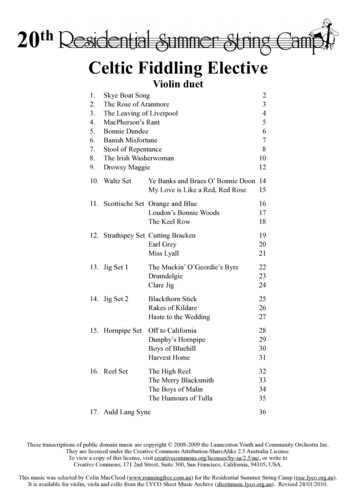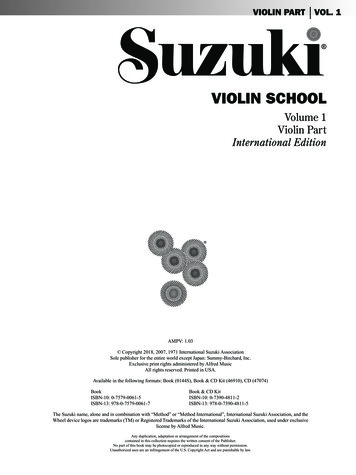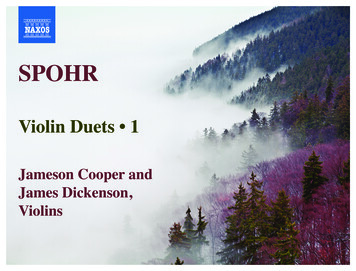
Transcription
SPOHRViolin Duets 1Jameson Cooper andJames Dickenson,Violins
Louis Spohr (1784–1859)Violin Duets 1Louis Spohr was born on 5 April 1784 in Brunswick(Braunschweig) and spent his early years in the little townof Seesen in the Harz mountains, where his father was adoctor. It was in Seesen that he received his early violintuition and wrote his first pieces. In 1797, havingovercome his family’s opposition to him becoming aprofessional musician, the 13-year-old Spohr returned toBrunswick alone to continue his violin studies with courtmusicians Gottfried Kunisch and Charles Maucourt and totake theory lessons with Karl August Hartung. His effortswere crowned with such success that little more than ayear later, in 1799, Duke Karl Wilhelm Ferdinand ofBrunswick gave him a position in his court orchestra. TheDuke also paid for Spohr to accompany the violinist FranzEck as a pupil on a tour to St Petersburg in 1802–03 tocomplete his training as a violinist.In 1804 Spohr made his first independent concerttour of Germany, gaining a reputation as one of thecountry’s leading violinists, and in 1805 he was invited tolead the court orchestra in Gotha. In 1813 Spohr movedto Vienna as Kapellmeister at the Theater an der Wien,but left again in 1815 to undertake an extended tour ofItaly. From 1817 he spent a year as director of opera atthe municipal theatre in Frankfurt am Main. A journey toLondon in 1820 to give concerts there established hisreputation in Britain.In January 1822, Spohr accepted the position ofKapellmeister at the court in Kassel, remaining there until1857. Whereas he had been considered the leadingGerman violin virtuoso until his appointment, hisappearances as a violinist now became increasingly rareand were mostly confined to Kassel. Instead, he was nowsetting standards as a conductor. He continued toperform chamber music in the salons of families withwhom he was on friendly terms until he broke his leftarm in 1857 and it failed to heal properly. Spohr died on22 October 1859 in Kassel.Spohr’s Violin Duets, WoO 21 are not only his earliestsurviving compositions, having been written in Seesenwhen he was about 12 years old, they are also the earliestpieces he mentions in his autobiography Lebenserinnerungen: ‘They were duets for two violins, which Iperformed at music evenings with my teacher, to myparents’ considerable astonishment.’The Violin Duets, Op. 3 and Op. 9 (1805 and 1807respectively) were among the earliest pieces to bepublished by Spohr. He added another set, Op. 39, in1816. However, these pieces were extremely difficult foramateurs to perform and didn’t sell as well as had beenhoped. In a letter dated 28 June 1823, Spohr thereforepromised his publisher, Carl Friedrich Peters: ‘As soon asI have put together a few new things for an autumn tour,I’ll try my hand at some easy duets. It’s very unlikely thatI’ll not be able to manage something simple for once!’Peters was clearly sceptical about this pronouncementand wrote to Spohr again almost a year later on 4 June1824: ‘My thanks to your dear wife for nagging you tocompose a set of duets, but for goodness’ sake don’tmake them so hideously difficult, otherwise we’ll miss themark again and the duets won’t be fit for my purpose.’Several more months elapsed before Spohr sent theViolin Duets, Op. 67 to his publisher on Christmas Eve,1824. At present, we have no indication from Peters as towhether Spohr’s writing was easy enough on thisoccasion. However, the sole contemporary review writesapprovingly: ‘Spohr’s violin duets assuredly occupy animportant place among his works. They combine musicalinterest and brilliant writing for the instruments to agreater degree than those of other composers for theviolin. Given that these new duets add to theaforementioned virtues that of ease of execution, they willbe all the more welcome to the music-buying public.’The same review considers the Op. 67, No. 1 duet tobe characterised by an overarching ‘grace andtenderness’. This duet is focussed on the first movement,which is significantly longer than the second and thirdmovements combined. As often in Spohr’s writing,modulation begins immediately after the exposition of themain theme; he is at one and the same time structuringthe movement and paving the way for fresh musicalideas. The first violin accordingly introduces the secondsubject on the back of an unaccompanied rising chromaticfigure in the second violin.Spohr links the two ensuing short movements so thatthey balance the first. Not only does the first violin carry overits last note of the Andante second movement as the firstnote of the third (Rondo vivace), but shortly before the endof the movement, Spohr repeats the first eight bars of theAndante as one of the episodes in the Rondo. Finally, theRondo begins not in its home key of A major, but in C major.This again reinforces the impression that the A major slowmovement constitutes a short introduction to the Rondo.Whereas the two themes in the first movement of No. 1are very similar to each other, Spohr differentiates thethemes in No. 2. The first subject has an incisive, dottedrhythm, whereas long, held notes predominate in thesecond subject. Spohr further points up the difference byhaving the first subject played in octaves by the twoviolins, whereas the use of double-stopping yields fourpart writing for the second subject.Spohr also exploits the contrast between a full soundand a leaner tone to structure the slow movement. Hebegins quietly, with double-stopping in both parts, whichrarely crescendo out of the prevailing piano to a forte.There follows a high-lying melody, played forte andaccompanied by broken chords in the other part, beforethe two instruments exchange roles and then at length themovement returns to its subdued opening.The concluding Rondo is, according to acontemporary review, ‘among the most genial and cheerfulthings Spohr has written’. And indeed, not only does themain theme bounce cheerily through the movement in adotted rhythm, but one of the secondary themes alsocombines dotted notes with suspended seconds.While No. 2 comprises the traditional threemovements, fast–slow–fast, and Spohr links the slowmovement to the Rondo in duet No. 1, No. 3 genuinelyconsists of only two movements. The first opensdramatically and forte with a thrice-repeated dotted motif,starting on a fairly high note. This is followed by a quiet,mollifying cantabile line before the impassioned openingis repeated. Following a few bars of passagework, the twocontrasting elements of the theme are combined in amelody played by each violin in turn, enriched with thechromatic overtones typical of Spohr’s writing. This isfollowed by a second theme whose repeated semiquaverfigures sound like a folk dance. A brief developmentsection again juxtaposes the two variants of the firsttheme, before the more melodious version appears toemerge victorious at the beginning of the recapitulation.The rough secondary theme is repeated by way ofcontrast, then after some more passagework, themovement ends majestically with the first of the twovariants of the main theme, played in the major.The second movement introduces a minuet theme –a movement form that was by then already a littleoutmoded. Spohr gives us five variations in what is one ofthe few theme-and-variations movements in his oeuvre.Spohr composed the Op. 67 duets at a time when hisindividual style was fully developed. By contrast, it is easyto discern that the Duet, WoO 21, No. 3 was written by a12-year-old who had not yet had any lessons in musictheory. All three movements have beautiful melodic ideas,but their movement is stilted. Moreover, there are audiblecompositional errors that are readily discernible even byan inexperienced listener. Or, as Spohr put it in hisLebenserinnerungen: ‘The duets my father carefullypreserved may be childish and incorrect, but they donevertheless have a form and a flowing melody line.’ Thismakes these three movements ideally suited to highlightjust how much Spohr had developed as a composer bythe time he wrote his Op. 67 duets.Karl Traugott GoldbachTranslation: Susan Baxter
Louis Spohr (1784–1859)Violinduos 1Am 5. April 1784 in Braunschweig geboren, wuchs LouisSpohr zunächst in der Kleinstadt Seesen im Harz auf, wosein Vater als Arzt tätig war. In Seesen erhielt er auch seinenersten Violinunterricht und verfasste seine erstenKompositionen. Nachdem Spohr seiner Familie gegenüberdurchgesetzt hatte, dass er Berufsmusiker werden wollte,kehrte der 13 jährige 1797 alleine nach Braunschweigzurück, um dort bei den Hofmusikern Gottfried Kunisch undCharles Maucourt weiteren Violin-, bei Karl August HartungTheorie-Unterricht zu nehmen. Damit war er so erfolgreich,dass ihn der Braunschweiger Herzog Carl WilhelmFerdinand bereits wenig mehr als ein Jahr später 1799 inseine Hofkapelle aufnahm. Der Herzog ermöglichte esSpohr auch mit einem Stipendium 1802/03 den ViolinistenFranz Eck nach St. Petersburg zu begleiten und auf einerKonzertreise bei ihm sein Violinstudium zu beenden. 1804unternahm Spohr seine erste eigene Konzertreise durchDeutschland, die seinen Ruf als einer der führenden Geigerin Deutschland begründete. 1805 erhielt er den Ruf, in Gothadie Hofkapelle zu leiten. 1813 wechselte Spohr nach Wienals Kapellmeister des Theaters an der Wien, das er jedoch1815 wieder verließ, um auf eine ausgedehnte Tourneedurch Italien zu gehen. Ab 1817 war er für ein Jahr Dirigentder Oper am Stadttheater in Frankfurt am Main. SeineKonzertreise nach London 1820 begründete seinen Ruhm inGroßbritannien. Im Januar 1822 trat er seine Stelle alsHofkapellmeister in Kassel an, die er bis 1857 bekleidete.Während Spohr bis zu seinem Engagement in Kassel als derführende deutsche Virtuose auf seinem Instrument galt, tratSpohr nun immer seltener in der Öffentlichkeit als Geiger aufund dann meistens in Kassel. Stattdessen setzte nun aberals Dirigent Maßstäbe. In den Salons befreundeter Familienführte er weiterhin Kammermusik auf, bis er sich 1857 denlinken Arm brach, der nicht mehr richtig verheilte. Spohrstarb am 22. Oktober 1859 in Kassel.Spohrs Violinduos WoO 21 sind nicht nur seinefrühesten erhaltenen Kompositionen, die er als etwazwölfjähriger um 1796 in Seesen schrieb. Sie sind auchdie frühesten Kompositionen, die Spohr in seinen Lebens-erinnerungen erwähnt: „Es waren Duette für zweiViolinen, die ich mit meinem Lehrer in den Abendmusikpartien vortrug und damit die Eltern im höchsten Gradeüberraschte“.Zu Spohrs frühesten Publikationen gehörten ebenfallsViolinduos, op. 3 (1805) und op. 9 (1807), denen Spohr 1816noch op. 39 hinzufügte. Diese Kompositionen waren jedochfür Liebhaber sehr schwer auszuführen und verkauften sichdaher nicht so gut wie erhofft. In einem Brief vom 28. Juni1823 versprach Spohr seinem Verleger Carl Friedrich Petersdaher: „Sobald ich mir einige neue Sachen zu einerHerbstreise gemacht haben werde, will ich mich einmal anleichten Duetten versuchen. Es müßte doch mit dem Teufelzugehen, wenn ich nicht auch einmal etwas leichtes zuStande bringen sollte!“ Peters traute dieser Ankündigungoffensichtlich nicht und ermahnte den Komponisten fast einJahr später am 4. Juni 1824 erneut: „Ihrer lieben Fraumeinen schönen Dank, daß sie Sie zur Composition einesHeftes Duetten angehalten hat, machen Sie solche nur nichtso grausam schwer, denn sonst schießen wir wieder nebenden Zweck zu welchem ich die Duetten haben will.“ Esdauerte noch einige Monate, bis Spohr seine Violinduos op.67 am Heiligabend 1824 an seinen Verleger absendete. VonPeters selbst ist derzeit keine Äußerung bekannt, ob Spohrdieses Mal leicht genug geschrieben habe. Die einzigezeitgenössische Rezension hebt aber lobend hervor: „UnterSpohrs Werken nehmen seine Violinduette gewiß einenhohen Rang ein. Sie verbinden, mehr als die der meistenViolin-Komponisten, musikalisches Interesse mit glänzenderBehandlung der Instrumente. Da nun diese neuen Duetteneben jenen Vorzügen noch den der leichterenAusführbarkeit besitzen, so werden sie gewiss demmusikalischen Publikum um so willkommener sein.“Dieser Rezension zufolge zeichnet sich das ersteDuo durch „Anmuth und Zärtlichkeit aus, die über dasganze verbreitet wird. Der Schwerpunkt dieses erstenDuos liegt offensichtlich auf dem Kopfsatz, der deutlichlänger ist, als die beiden folgenden Sätze zusammen. Wiehäufig bei Spohr, beginnen gleich nach Vorstellung desHauptthemas harmonische Modulationen. Gleichzeitiggliedert der Komponist diesen Satz und bereitet neuemusikalische Gedanken deutlich vor. So leitet die ersteVioline die Vorstellung des Seitenthemas durch eine vonder zweiten Violine unbegleiteten chromatischenAufwärtsbewegung ein.Damit die beiden folgenden kurzen Sätze einGegengewicht zum Kopfsatz bilden, verbindet Spohr siemiteinander. Nicht nur hält die erste Violine ihren letztenTon aus dem zweiten Satz (Andante) zum ersten Ton desdritten Satz (Rondo vivace) hinüber, kurz vor Ende desdritten Satzes wiederholt Spohr auch noch einmal dieersten acht Takte des Andante als Episode innerhalb desRondos. Schließlich beginnt das Rondo nicht in seinerGrundtonart A-Dur, sondern in C-Dur. Dies unterstreichtnoch einmal den Eindruck, dass der langsame Satz in ADur eine langsame Einleitung für das Rondo darstellt.Während die beiden Themen im Kopfsatz des erstenDuos einander sehr ähnlich sind, differenziert Spohr dieThemen im zweiten Duo: das Hauptthema hat einenprägnant punktierten Rhythmus, dagegen herrschen imSeitenthema lange Noten vor. Spohr verstärkt dieUnterschiede noch, indem er das Haupthema zunächstvon beiden Violinen in Oktaven vortragen lässt, wogegendas Seitenthema im durch Doppelgriffe realisierten vierstimmigen Satz steht.Den Gegensatz zwischen voll- und geringstimmigenKlang nutzt Spohr auch für die Gliederung des langsamenSatz‘. Er beginnt verhalten mit Doppelgriffen in beidenStimmen, die sich nur selten aus dem piano zum fortesteigern. Es folgt im forte eine Melodie in hoher Lage, dievon der anderen Stimme mit Akkordbrechungen begleitetwi
SPOHR. Violin Duets 1. Jameson Cooper and James Dickenson, Violins. main theme; he is at one and the same time structuring the movement and paving the way for fresh musical ideas. The first violin accordingly introduces the second subject on the back of an unaccompanied rising chromatic figure in
